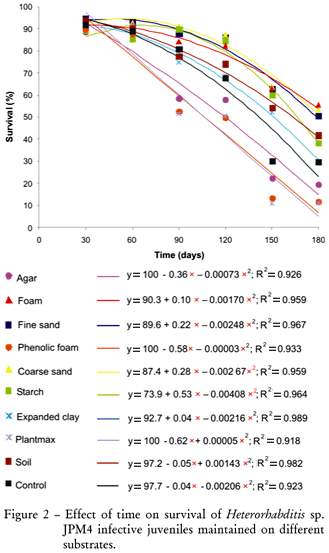The survival of entomopathogenic nematodes under laboratory conditions is low. With the aim of evaluating substrates to extend the survival of entomopathogenic nematodes, suspensions of Heterorhabditis sp. JPM4 and Steinernema carpocapsae All (3,000 IJ mL-1) were added to dirt, fine sand, coarse sand, foam, expanded clay, phenolic foam, agar, corn starch, Plantmax®, and water. The substrates were placed on Petri dishes (5 cm) and kept at 16 ± 1°C. Survival evaluations were made after 30, 60, 90, 120, 150, and 180 days, with three replicates. After 180 d, a greater percentage of S. carpocapsae infective juveniles (IJs) were still alive in the foam treatment (57.5%) as compared to other treatments, while expanded clay (28.4%), Plantmax® (9.3%) and phenolic foam (11%) were not effective in maintaining the survival rate. Foam (55.6%), coarse sand (53.1%), and fine sand (50.6%) provided greater Heterorhabditis sp. JPM4 IJ survival at 180 days. Agar (19.3%), phenolic foam (11.6%), and Plantmax® (10.7%) had lower survival indices than the control (29.7%). The use of an appropriate substrate can provide greater IJ survival.
Heterorhabditis; Steinernema; biological control; persistence; survival




